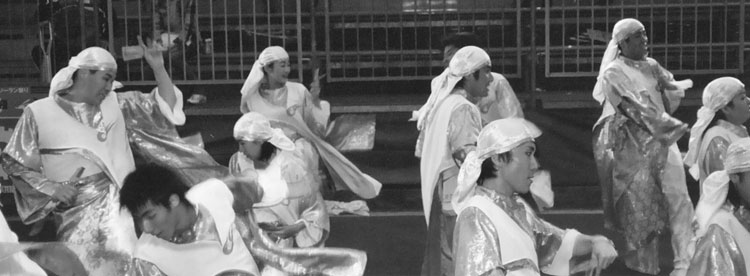Yosakoi Soran in Sapporo

Seventeen years ago, a university student in Sapporo, Hokkaido, Japan, upset with the island’s horrible winters (average snowfall is 240 inches), decided to start Yosakoi Soran, a celebration in early June, as a sign that winter was finally over and everyone could enjoy a few months of relief.
From a small group in the first few years, this event has grown to, in 2008, over 340 groups comprising over 45,000 dancers seen by well over two million spectators. The population of Sapporo more than doubles for the duration of the 5-day festival.
This year the festivities officially began in Odori Park at 5:45 p.m., June 4, with groups appearing one after another onstage until 10 p.m. The second day was the exact same thing, except it started at 6 p.m.
On Friday night, beginning at 4:30, the groups were no longer confined to a stage. They were in the streets in three places in the city. On Saturday and Sunday, dancing occurred in over 20 places, so groups of dancers were moving en masse from one area to another; this was what the months of practice were for.
Finally, the ceremonial proceedings turned into ‘letting it all hang out.’ I’ll try to describe what goes on, but I cannot do it justice.
As I walked the streets, I saw group upon group in constant movement. Imagine anywhere from 25 to 100 dancers in brightly colored costumes doing coordinated routines in ever-changing patterns. Some groups even use masks, makeup, fans, special hats — you name it.
Some very professional groups were sponsored by large companies: Coca-Cola, DoCoMo (the largest cell phone company in Japan), Sapporo beer, etc. Dance groups also came from South Korea and China. There was even a wheelchair group. It is an honor to have a dance group, and many of them practice for months and months.
The dancing was broadcast live throughout Japan. There was a contest, judging on originality and uniformity, and the top 10 groups were announced on Sunday night.
There was no charge to watch the five days of celebration, but you could pay for reserved seats for the first two nights and reserved seating areas during events on Saturday and Sunday. Both were sold on site on a first-come, first-served basis. I paid ¥1,000 ($10) for 1½ hours in the reserved seating area, which, with over two million spectators floating all over the city, was well worth it. (Don’t even think about finding a hotel room in town during the festival!)
I have attended this festival four times, watching it grow and mature to an event unmatched anywhere.
STANLEY OSUR
Hawthorne, NJ
